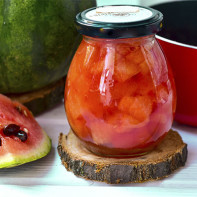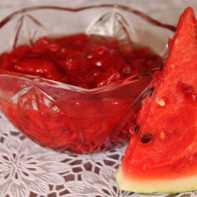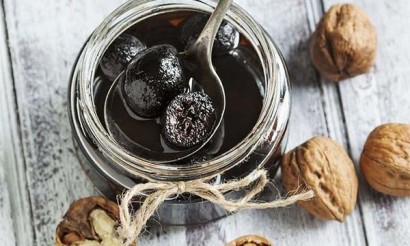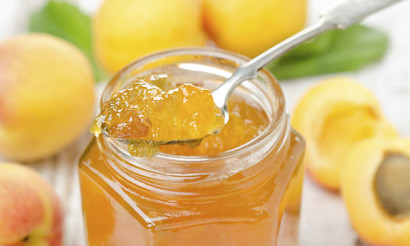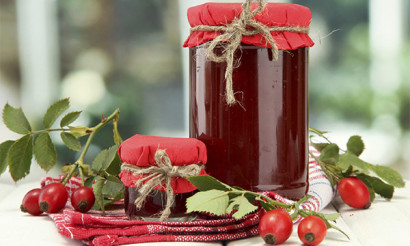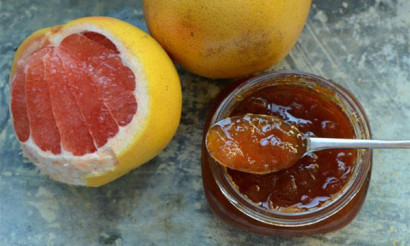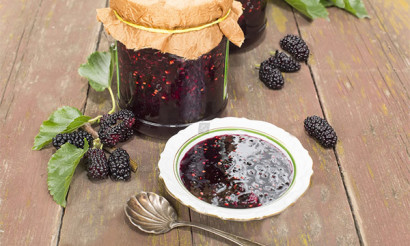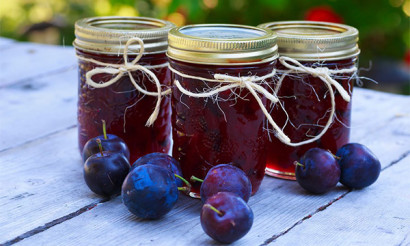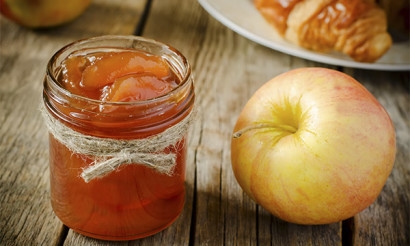Watermelon jam: 6 Recipes
Sweet, juicy watermelon mellows on the tongue from the middle of August. It's a shame that the season ends so quickly. But you can go for a little trick and stock up on some fragrant delicacy for the winter, making jam from watermelon pulp according to a variety of recipes. And then on cold frosty evenings to open a jar, tasting the wonderful dessert and choosing the most successful flavor, so that next summer to cook such a delicacy more.
- Watermelon Question
- Composition and calories
- Useful properties of watermelon
- What is useful of watermelon pulp jam
- How to choose watermelon for jam
- How to cook watermelon pulp jam: Recipes
- classic
- Watermelon honey
- Kubanochka
- With Raspberry
- With walnuts
- Ginger and mint mix
- Storage conditions of watermelon jam
- Interesting facts about watermelon
Watermelon Question
There is a very interesting situation with this plant. Until now, scientists have not decided where to classify watermelon - as a berry or a fruit. In the recipe books, too, it is not clear in which section to look for the preferred method of preparation. But in this case, folk wit put the scientific approach on both sides, ingenuously calling watermelon a "melon crop. That was the end of the argument on a domestic level, and the recipes for winter preserves were scattered under the sections on pickles, marinades, and sweet desserts.
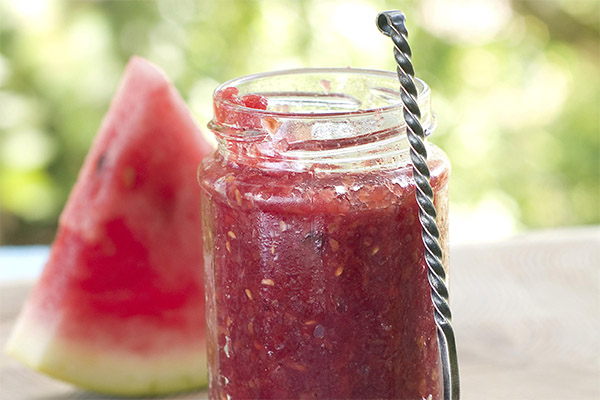
The taste of watermelon depends on the region where it is grown. The crop requires a wide space, since its branches are creeping, reaching up to 4 m. They produce light yellow flowers, then ovaries. For the fruits to be large, only a part, no more than 8-10 pieces per plant are left, and the rest are removed.
The ancestor of the tsamma melon, which grows in South Africa, is thought to be the melon. Mentions of the crop are found in ancient Egypt as a source of water, food and medicine. Many varieties and hybrids have been developed from the wild species, differing in shape, size, taste, and ripening time. Many of them are acclimatized for central and northern regions.
Composition and calories
Like the cucumber, water makes up most of the flesh of the watermelon. It contains many useful substances, which is actively used in programs of weight control, general health improvement, and cosmetology.
Especially important for health are antioxidants and the unique amino acid citrulline. Of equal value are:
- fructose;
- glucose;
- pectins;
- alkaline substances;
- vitamins A, C, E, PP, group B;
- iron;
- magnesium;
- calcium;
- phosphorus;
- potassium;
- zinc;
- niacin;
- starch;
- essential amino acids;
- saturated and polyunsaturated fatty acids.
The caloric value of a piece weighing 100 g does not exceed 27-28 kcal, while the glycemic index is very high, which must be considered in diseases related to metabolism.
The seeds of the fruit are rich in oily substances containing palmitic, linoleic and linolenic acids. Watermelon seed oil is similar to olive oil in taste and almond oil in physical and chemical properties. It is often used as a base for oil massage compositions.
Useful properties of watermelon
Virtually any part of this melon crop goes to work. The flesh has a powerful diuretic, anti-edematous, anti-inflammatory, antipyretic effect. Small portions of watermelon activate intestinal peristalsis, eliminate constipation, remove toxins and waste products.
Regular introduction of fruit to the diet strengthens the immune system, supports visual acuity, improves skin elasticity and accelerates the breakdown of fats. Magnesium is useful for the female body at any age, supporting the rate of metabolism, stabilizing the nervous system, eliminating the preconditions for cramps and the contraction of smooth muscles, which is especially important during pregnancy.
Interesting: The pulp of watermelon contains a significant proportion of L-citrulline, which stabilizes the condition of blood vessels and prevents sudden spikes in blood pressure.
Watermelon is valued for its ability to:
- Inhibit the development of cancer cells;
- Neutralize the effects of oxidative processes;
- prevent premature aging;
- stimulate kidney function;
- Restore microflora after a long course of medical treatment;
- Improve the function of the liver, reducing the burden on it.
Men should not neglect the sweet pulp and try in the season to replenish the body with valuable amino acids, which improve potency and increase sex drive.
For women, a great benefit are the seeds, in which the amount of magnesium is one and a half times the daily dose. But juicy slices of pulp will also come in handy, reducing emotional stress, eliminating swelling, improving skin turgor and complexion.
How is watermelon pulp jam good for you?
After heat treatment, most of the useful substances are lost or broken down into simpler ones. But even half in winter is much better than nothing, so you should not miss the moment. Even as a treat, watermelon retains diuretic and anti-inflammatory effects, but in much more modest amounts. But the concentration of lycopene increases several times. When boiled for a long time, its quantity only increases. This enzyme is necessary for the prevention of early aging, maintaining skin elasticity and smoothness. It is able to bind and eliminate free radicals. Lycopene stops the malignant transformation of cells, so it is especially valuable for those who have a predisposition to cancer.
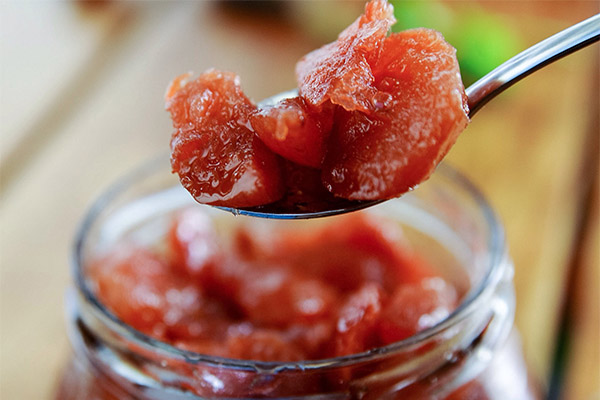
Fiber also does not undergo special metamorphosis, remaining almost unchanged and retaining the functions of activating peristalsis and cleansing the body. It is able to restore the microflora of the intestine, adjusting the work of the gastrointestinal tract. Due to this, the skin is cleared of irritation and rashes. Fiber protects against obesity, stabilizes cholesterol levels.
Watermelon jam restores lost energy during prolonged physical exertion, retains visual acuity, keeping the eyes from age-related dystrophy. It removes part of uric acid and maintains water-salt balance, as well as activates the work of the kidneys.
How to choose a watermelon for jam
For twisting in a marinade you need unripe fruits, and the preparation of sweet desserts requires only well ripened, sugary watermelons. The sweeter they are, the less sugar is needed. In addition, you can use additional ingredients that give the jam a unique flavor.
Important: Prepare a treat only in season, early watermelons may contain a large amount of pesticides and other substances used to accelerate the harvest.
If you focus on varieties, the sweetest are considered:
- Ogonek. Characterized by bright red flesh with small seeds, small size.
- Sugar baby. Characterized by early maturity, dense rind, excellent taste.
- Crimean Rose. Cultivated in small quantities, practically non-transportable, but the taste is amazing.
- Astrakhan. Gives large fruits with sugar flesh.
- Kholodok. Refers to late varieties, long stored.
- Foton. Has a thick crust, suitable for the preparation of candied fruits, which makes it doubly valuable.
The principle of choosing a ripe fruit is the same for any variety.
- The main criterion is a ringing sound when you click on the side of the fruit. A ripe watermelon springs when you clap it with your open palm, the second hand can feel the recoil well.
- The sweetest will be the unwatered crop. In this case, the plants are watered until the formation of ovaries, after the beginning of ripening, the water supply is stopped.
- An important condition is the integrity of the crust. Cracks, soft fragments, traces of rot are not allowed.
- There must be a light spot on the side. It is formed from contact with the ground during growth. If it is not present, then the fruit has been picked green and brought to ripeness by artificial means.
- The "tail" in a slightly dried and twisted state indicates ripeness and sweetness.
- Size does not affect the taste, as well as the hue of the rind, if the parameters correspond to the signs of the variety. To make jam it is more convenient to choose the last week of August and early September. At this time there is a mass collection of watermelons, they are mostly already ripe in a natural way, the cost is close to the minimum for the season. The fact is not unimportant, since from the original volume in the finished form remains at best 1/3.
How to make jam from watermelon pulp: recipes
There is a very high percentage of water in gourds. In the process of cooking, it evaporates, thickening the consistency of the mass, so you have to have patience and constantly stir the jam, otherwise it will quickly burn. Enameled container is suitable only for defending the mixture, cook the dainty better in aluminum, copper, brass basin or a saucepan with Teflon coating. Stir more conveniently with a wooden spatula. It does not leave traces on the bottom, does not crush the berries and pieces of fruit, gently moving them in the syrup. Recipes for watermelon pulp jam are divided into traditional and exotic, and united by their stunning taste, from which it is simply impossible to come away.
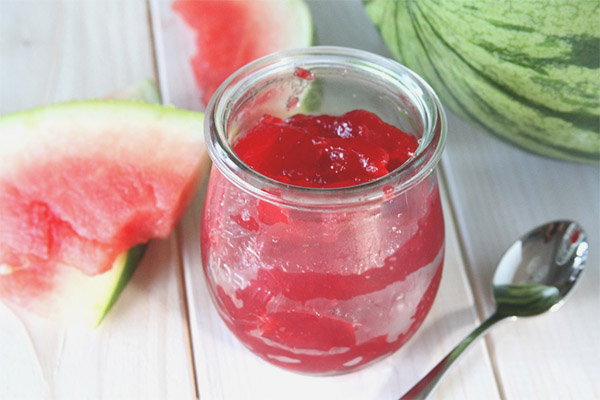
Classic
You only need 2 ingredients - watermelon and sugar in a 1:1 ratio. The most tedious and nasty part is to carefully remove the seeds from the pulp. You can go on the sly and first boil a little mass, and after cooling, rub it through a sieve. Then the consistency will be more like jam, but it will not affect the taste.
First, the pieces are filled with sugar and left for 2-3 hours to separate the juice. At the first boil, the syrup is boiled for 2-3 minutes separately. They pour the slices and leave for 8-10 hours to soak. The next 2 approaches boil the jam for only 5 minutes with continuous stirring. Then the boiling mass is poured into jars and hermetically sealed.
Watermelon honey
It is much more popular and familiar in the Volga region and Astrakhan region, where gourds are traditionally grown and get abundant yields. The difference from the classic recipe is the duration of preparation and mandatory crushing to puree. The sugar consumption is very economical, for sweet varieties at full ripeness you will need only 250 grams per 3 kilograms of pulp. The seeds can not be removed beforehand, they will be removed after straining through a sieve.
The chopped pulp is placed in a saucepan with a thick bottom and simmered for about 30 minutes with continuous stirring. Once all the pieces are completely soft, the mass is ground in a blender or rubbed immediately through a sieve. You can transfer everything to gauze and squeeze well. The resulting juice with a small percentage of the pulp in the pot, cook for about 3 hours, until the mass thickens. Honey sweets transferred to small jars.
Kubanochka .
From the classic recipe differs with the addition of lemon. For 1 kg of sugar take 1.5 kg of pulp and a large lemon. Peel the peel, squeeze the juice from half of the fruit. Boil in two parts. Diced lemon cubes fill with sugar and boil on a very low heat for 5 minutes from the boiling point. The mass should cool, after which it is boiled again, but with the addition of lemon juice and zest.
The jam turns out very beautiful with translucent pieces and a tangy sourness. Store it preferably in a cool place.
With raspberries
Original mix of raspberries and watermelon. For the preparation you will need:
- watermelon - 3 kg;
- sugar - 300 gr;
- raspberry - 150 gr;
- pectin - 60 gr;
- juice of 1/4 of a lemon.
Squeeze juice from the pulp, mix with sugar and pectin, bring to a boil. After 5 minutes add lemon juice, another 3 minutes - raspberries. The mixture is kept on the fire for 4-6 minutes with constant stirring. This jam looks very beautiful in small barrel-shaped jars. The transparent pink syrup is embossed with ruby raspberries. This delicacy will be a worthy decoration for any tea party.
With walnuts
A method for those who can not afford the luxury of brewing a treat in several batches, but really love deliciousness. In addition to the traditional watermelon and sugar in the proportion 2:1, you will need a handful of walnuts peeled and chopped into small pieces. Half a teaspoon of ground black pepper adds an unexpected touch. It is not bitter, but gives a feeling of warmth in the aftertaste. Cook in one pass, 40 minutes on low heat, gently stirring the mass from the bottom to the edge. In the finished state it should slightly thicken and stretch well from the spoon. The nuts turn out crunchy and the peppers add spice.
Ginger-Mint Mix
The searing freshness of ginger and the coolness of mint are woven seamlessly into the watermelon base. The recipe calls for 1 kg each of sugar and pulp, 30 fresh mint leaves and a dessert spoonful of ginger shavings. The watermelon pulp is cut into slices, covered with sugar and left in a warm place for 2 hours. Mint is chopped and mixed with the main mass. After 8 minutes of boiling add ginger. The mixture is boiled for 3 minutes, then removed from the stove and allowed to stand for 1 hour. The delicacy is spread into sterilized jars and hermetically closed.
It is worth considering: sterilization is carried out in the oven only by dry method. There must not be any drops of water in the jars, otherwise the jam will "ferment".
A similar way to make jam with rosemary instead of ginger.
Storage conditions for watermelon jam
The recipe does not involve long boiling of the pulp. The jam turns out very delicate and quite capricious in storage. It is best to leave the bottom shelf of the refrigerator for jars with a delicacy. This is especially true for the recipe with raspberries, since you get practically five minutes. Not bad will stand jars in a cool cellar or on an insulated loggia.
The exception is watermelon honey. It cooks for a long time, the liquid is almost evaporated and the finished product is not afraid of the inner shelves of kitchen cabinets and the pantry in the hallway.
Interesting facts about watermelon
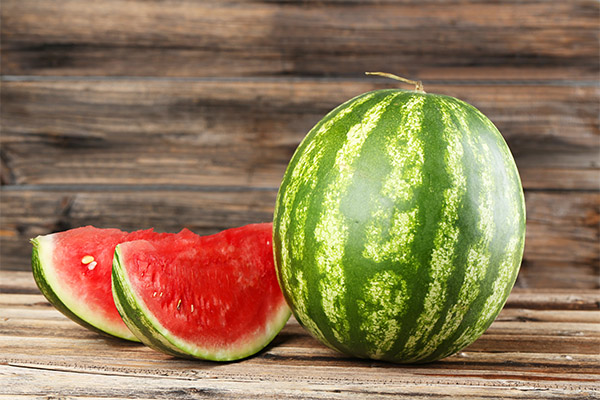
- The plant was well known in ancient Egypt, grown along with other crops, used for food and medicinal purposes.
- The flesh of the fruit is 92% water.
- The plant is native to South Africa.
- In Russia, the first attempts to grow melons date back to the 17th century.
- An exact botanical classification for watermelon has not yet been found.
- There are about 1200 varieties and hybrids of sweet fruit, including dwarf, giant, oval and square varieties.
- Breeders have created hybrids in yellow and black.
- The largest watermelon was grown by Lloyd Bright, the weight of the fruit reached 122 kg, the record was set in the USA.
- Dwarf watermelons do not grow more than 3-4 cm, a variety cultivated in South America, called Pepquinos. The fruits taste like a cucumber and are in demand in restaurants as ingredients in exotic salads.
- An adult can eat up to 3 kilograms of sweet slices per day without harming their health.
- Most often watermelon is eaten fresh, but as a jam, it acquires completely new flavor shades and becomes an exquisite dessert.
«Important: All information on this site is provided for informational purposes only. for informational purposes only. Before applying any recommendations, please consult with a health care professional. specialist before using any of the recommendations. Neither the editors nor the authors shall be liable for any possible harm caused by materials."



